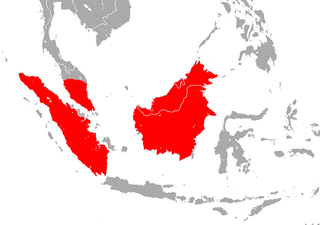
The black-capped fruit bat is a species of megabat in the monotypic genus Chironax.

The dayak fruit bat or dyak fruit bat is a relatively rare frugivorous megabat species found only on the Sunda Shelf of southeast Asia, specifically the Malay Peninsula south of the Isthmus of Kra, and the islands of Borneo and Sumatra. There are three species in the genus Dyacopterus: D. spadiceus, D. brooksi and D. rickarti. All are found in the forests of Malaysia, Thailand, and the Philippines. Few specimens of any of the three species exist, due not only to their rarity, but also because they rarely enter the sub-canopy of the forest where they can be caught in scientists' nets.

The moonrat is a southeast Asian species of mammal in the family Erinaceidae. It is the only species in the genus Echinosorex. The moonrat is a fairly small, primarily carnivorous animal which, despite its name, is not closely related to rats or other rodents. The scientific name is sometimes given as Echinosorex gymnurus, but this is incorrect.

The Sunda laughingthrush is a bird species in the family Leiothrichidae. It is found on the islands of Sumatra and Borneo in Brunei, Indonesia, and Malaysia.

The Borneo roundleaf bat or Bornean leaf-nosed bat is a species of bat in the family Hipposideridae. It is found in Borneo, Sumatra and Peninsular Malaysia. Hipposideros sabanus is a synonym of this species.
Heptapleurum cephalotes is a species of plant in the family Araliaceae. It is native to Borneo, Sumatra, Peninsular Malaysia, and Peninsular Thailand. The native population in Singapore is presumed extinct. It has been introduced to the Andaman Islands.

Pterophylla fraxinea, formerly known as Weinmannia fraxinea, is a tree in the family Cunoniaceae. It grows up to 40 metres (130 ft) tall. The bark is grey to dark brown. Inflorescences bear up to three pairs of flowers. The specific epithet fraxinea is from the Latin meaning "ash tree", referring to the leaves' resemblance to those of the genus Fraxinus.
Quercus merrillii is an Asian species of shrubs in the beech family Fagaceae. It has been found on the Island of Palawan in southwestern Philippines and also in the Malaysian parts of the nearby Island of Borneo. It is placed in subgenus Cerris, section Cyclobalanopsis.
Quercus argentata is an evergreen tropical oak species in the beech family Fagaceae. There are no known subspecies. It is placed in subgenus Cerris, section Cyclobalanopsis. It derived its name from the silvery hairs on the lower surface of its leaves.

The Peninsular Malaysian montane rain forests is an ecoregion on Malay Peninsula. It occupies the mountainous spine of the peninsula in Malaysia and southernmost Thailand. It is in the tropical and subtropical moist broadleaf forests biome.
Quercus lowii is a species of oak (Quercus) native to the mountains of northern Borneo.
Quercus lineata is a species of Quercus (oak) in the beech family Fagaceae, belonging to subgenus Cerris, section Cyclobalanopsis. It was first described by Carl Ludwig von Blume.
Quercus kinabaluensis is a species of oak endemic to the mountains of Borneo. It is placed in Quercus subgenus Cerris, section Cyclobalanopsis.
Quercus chrysotricha is a species of oak endemic to Borneo, where it is known only from Mount Dulit in Sarawak. It is placed in Quercus subgenus Cerris, section Cyclobalanopsis.
Quercus elmeri is a species of oak native to Borneo, Sumatra, and Peninsular Malaysia. It is placed in Quercus subgenus Cerris, section Cyclobalanopsis.
Quercus pseudoverticillata is a rare species of oak in the family Fagaceae. It is endemic to Mount Kinabalu on Borneo.
Quercus kerangasensis is a species of oak native to Borneo. It is placed in Quercus subgenus Cerris, section Cyclobalanopsis.
Quercus percoriacea is a species of oak endemic to Borneo, where it is known only from northern Sarawak state of Malaysia. It is placed in Quercus subgenus Cerris, section Cyclobalanopsis.
Quercus steenisii is a species of oak. It is a tree native to northern Sumatra.







